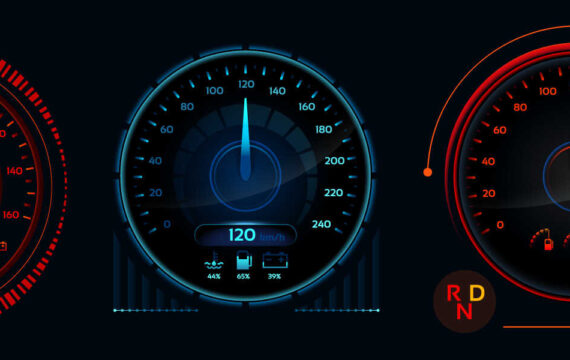CES 2022 took place from January 5 to 7 in Las Vegas. This was a one-of-a-kind event in many aspects. One of them was the huge emphasis on LiDAR and other sensor technologies showcased in the automotive space. I recently sat down with Oleksandr Odukha, Vice President of Automotive Delivery at Intellias, to discuss insights from CES 2022 and — more importantly — shed some light on how Intellias can support LiDAR-developing companies as well as car manufacturers in introducing these solutions to series production.
As the differences in LiDAR hardware are getting smaller and smaller, the provided software and integration solutions make the difference.
Patrick: Luminar, Ouster, Blickfeld, Robosense, and many more. When walking through West Hall and North Hall of CES 2022 in Las Vegas, the sheer number of companies offering LiDAR solutions was impressive. How would you describe the current state of the LiDAR landscape?
Oleksandr: Given what was presented during CES 2022, we can conclude that hardware-wise, it seems like the industry has decided to go for solid-state solutions with a range of 200 to 300 meters. This is typically enough for trucks and even high-speed applications. The solutions provide a good resolution to identify objects such as motorcycles or people at this range. Though the specifications vary from vendor to vendor, it seems as if there is a very reasonable range. An advantage in one area, such as range, subsequently comes with a trade-off in another area, such as resolution. However, one of the biggest challenges still seems to be mass production and pricing, especially as more than one LiDAR sensor will be needed for SAE Levels 4 and 5 to have the required field of view and create the necessary redundancy. On top of that, other sensor types might be needed too.
Patrick: So apart from pricing and hardware capabilities, what are key differentiators when it comes to the different LiDAR technologies?
Oleksandr: The second thing that differentiates companies is what kind of software and which software stack they provide. If we simplify the model, we can think about three layers: First, there is the sensor layer that includes all the software needed for the sensor to operate, such as drivers, integration with the operating system, and so on. This layer brings data from the hardware sensor to higher levels of software. The second layer is the perception layer. In the case of LiDAR, you build a point cloud, which is a kind of 3D depth map. This creates an option to apply different techniques and approaches, which usually involve neural networks to extract features from the depth map to identify objects such as vehicles, people, traffic lights, and road lines.
These extracted objects and features empower the third layer, namely the motion planner. This is the actual layer that controls the car — how it steers, accelerates, decelerates, etc. This layer needs additional logic using the perception layer to understand features around the vehicle. Based on these features and direct and indirect rules, the proper trajectory for the car is derived along with all other things needed for it to operate safely on public roads.
We can give LiDAR providers a competitive edge by helping them offer the full software package, including the sensor layer and perception layer.
Patrick: What are differentiators for LiDAR companies, and how can Intellias support them as well as their customers?
Oleksandr: Intellias can offer services for both sensor and perception layers. Working directly with LiDAR companies, we can give them a competitive advantage by making sure they offer a complete package to their customers. On the other hand, we can support Tier 1 and OEM customers who have already decided on a LiDAR technology provider by offering the necessary integrations and enhancements of the perception layer if not yet provided by the vendor.
Patrick: So the big differentiator for LiDAR companies is the software solutions they provide for the defined layers. Can you be a bit more specific? What does this mean for the sensor layer, for example?
Oleksandr: Of course, the bare minimum to be provided is the entire sensor layer, which integrates the LiDAR in different applications, operating systems, etc. Ideally, this should go beyond providing generic drivers for specific sets of operating systems and should support all architectures. So the better the package at this end, the easier the integration into the vehicle. Intellias, an experienced software engineering partner, can help to either develop the software package that accompanies the hardware or serve as an independent integration partner, taking over responsibility on behalf of either the OEM or LiDAR technology provider. This integration work focuses on decreasing latency to speed up data availability for processing by the perception layer.

Patrick: Okay, and how about the perception layer? I assume this should be provided by the LiDAR companies, too.
Oleksandr: Yes, indeed. But not every LiDAR provider is doing so. Even if they do, software solutions are often offered in the form of a license that needs to be bought by the customer. In addition, a big, big difference is what exactly this software can extract. It might provide basic features like road edges and cars. But if something more advanced is needed, it requires significant changes. Last but not least, it is all about the support that can be expected for these layers. Again, we can either act as an interface between both LiDAR companies and car manufacturers or support LiDAR companies directly, thus giving them a competitive edge in the decision-making phase.
The perception part requires a lot of optimizations and testing with SOTIF (Safety of the Intended Functionality) as an addition to ISO 26262. The key question is how to ensure there will be no failures or performance degradation under real-life conditions.

Patrick: Oleksandr, thanks a lot for these insights. One last question: What is your view on how the market will evolve?
Oleksandr: As we have already mentioned, we are at the interception today: OEMs and big Tier1 companies need to take the LiDAR hardware, optimize the sensor layer, verify the perception layer, ask for it to be extended when needed, and then write the motion planner on their own. This is less convenient than buying an out-of-the-box solution. So I believe we will see a drift in that direction, and we shall see LiDAR vendors focusing on providing the entire software stack. As a partner, Intellias is ready to support customers in achieving this kind of turnkey solution. Moreover, today many companies provide LiDAR hardware, but they do not provide an entire hardware package to be integrated into the car. Such a package consists of cleaning solutions heating, water spray, air spray, blowers, etc. – all to ensure that it can operate under real-world conditions. Again, easy integration is the key to success.




